RPID Customer Satisfaction Survey to Inform the Futures Programme
The Scottish Government’s Rural Payments and Inspections Division (RPID) commissioned Ipsos MORI Scotland to measure customer satisfaction with the services of the division and its partner organisations Forestry Commission Scotland and Scottish Natural Heritage.
2 Contact with RPID and Partner Organisations
Summary
1. Most customers interact with RPID and its partners through their local office and the Scottish Government website. Customers mainly seek information or guidance relating to application processes, schemes and payments.
2. In future, customers still wish to receive information from RPID and its partners through the same methods - from their local office, by post, and from the Scottish Government website - but they are also open to receiving information via email or text.
2.1 The main ways customers interact with RPID are by telephone or personal contact with their local RPID office. As part of the Scottish Government's digital agenda, the Futures Programme seeks to encourage more use of online services. Slightly more than half of customers already use the Scottish Government website to access information and services offered by RPID and its partners, but it is important for RPID to seek to increase take-up of its online services.
2.2 Overall, RPID customers receive information on rural or agricultural issues from a broad spectrum of sources. Almost equal proportions mention the Scottish Government and its partner organisations (30% mentioning one or more) and media outlets (33%). Other sources are mentioned by 67% of respondents. RPID or the Scottish Government was the most-mentioned source of information, by 28% of respondents, while Forestry Commission Scotland and Scottish Natural Heritage were mentioned by only 2% and 1% of respondents respectively. The farming and rural media were important sources of information. Scottish Farmer was mentioned by 21% and the Press and Journal by 13%, with 13% mentioning unspecified farming-related publications. Trade bodies such as NFU Scotland were mentioned by 17% of respondents, and the Scottish Agricultural College/SRUC by 14%. The ten most-mentioned sources are shown in figure 2.1 below.
2.3 Agents (42%) and crofters (38%) were more likely than overall (28%) to receive information from RPID or the Scottish Government. Farmers were more likely to receive such information from publications like Scottish Farmer (26% versus 21%) and Farmers Weekly (11% compared with 8%). Getting information from trade bodies such as NFU Scotland was more common among farmers and other rural businesses than it was for crofters (18% and 24% respectively compared with 10% of crofters).
2.4 Telephone respondents were more likely than online respondents to report receiving most of their information from RPID or the Scottish Government (43% compared with 15%) or to specify media sources such as Scottish Farmer (34% versus 8%), the Press and Journal (27% versus 1%) or Farmer Weekly (15% compared with 1%). However, online respondents were more likely than telephone respondents to report unspecified media sources (22% compared with 3%) or farming publications (15% compared with 4%).
2.5 Agents, other rural businesses, and non-SAF applicants were more likely than overall to receive information from Forestry Commission Scotland (15%, 4% and 13% respectively, compared with 2% overall). Similarly, agents and non-SAF applicants (both 4%) were more likely than overall (1%) to have received information from Scottish Natural Heritage.
Figure 2.1: Sources used to receive most information on rural and agricultural issues
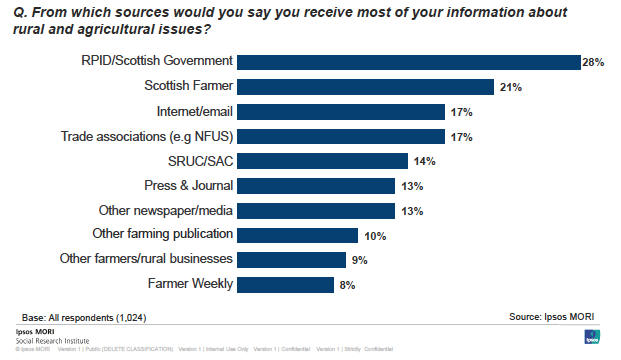
2.6 Respondents were asked about the specific types of information they had sought from RPID or its partner organisations. Around half of customers reported having obtained guidance on how to complete an application or guidance that specifically related to an application or payment from RPID in the last twelve months.
2.7 Forty-five per cent had obtained news about rural or agricultural issues from RPID or its partners, while 43% obtained information on eligibility and conditions for rural schemes. Overall results are shown in figure 2.2 below.
2.8 A quarter of respondents reported that they have not obtained any information from RPID or its partners in the past 12 months.
2.9 Other rural businesses and agents were more likely than overall to obtain information on rural scheme eligibility and conditions - 74% and 71% respectively, compared with 43%. Other rural businesses and agents were also more likely than overall to obtain information on their specific payment or application (69% and 67% respectively, versus 47%), and to look for guidance on how to complete an application (both 66%, compared with 52%).
Figure 2.2: Information or guidance obtained from RPID or its partners
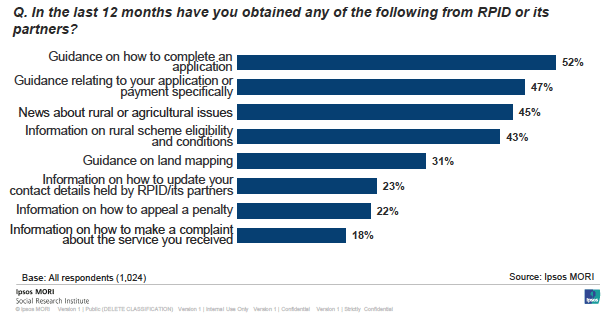
2.10 Paper SAF applicants were more likely than overall to obtain information on how to appeal a penalty (28% versus 22%) and on how to make a complaint about the service they had received from RPID or its partners (23% compared with 18%).
2.11 Online respondents were more likely than telephone respondents to have sought news about agricultural news or issues (50% compared with 40%) or information on rural scheme eligibility and conditions (50% compared with 36%), while telephone respondents were more likely than online respondents to have sought information on how to appeal a penalty (33% compared with 11%), information on updating contact details (29% compared with 18%) or information on how to make a complaint (27% compared with 9%).
2.12 The most-reported means for obtaining these types of information were from customers' local RPID office (64%) and the Scottish Government website (57%). Around half (49%) of respondents did so in the form of postal correspondence from RPID, while one in four obtained information from the RPID head office or the Rural Issues newsletter. Overall results are shown in figure 2.3 below.
2.13 Seventeen per cent of respondents said that they had obtained such information from the Forestry Commission Scotland office or website, while 14% did so from the Scottish Natural Heritage office or website.
2.14 Of those respondents who had obtained information from more than one source, around one-third (34%) said that they obtained most of their information from their local RPID office or from the Scottish Government website (31%).
Figure 2.3: All methods used to obtain information from RPID or its partners
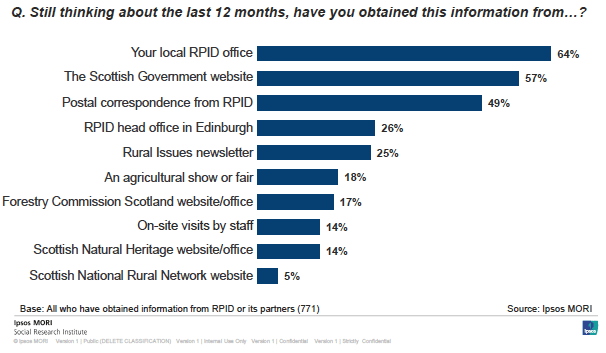
2.15 Overall, respondents' main sources of information from RPID and its partners were their local RPID office (34%), the Scottish Government website (28%), or from postal correspondence from RPID (19%). The Forestry Commission Scotland or Scottish Natural Heritage office or website was reported as the main source of information by 5% and 1% of respondents respectively. See figure 2.4 below.
Figure 2.4: Main method used to obtain information from RPID or its partners
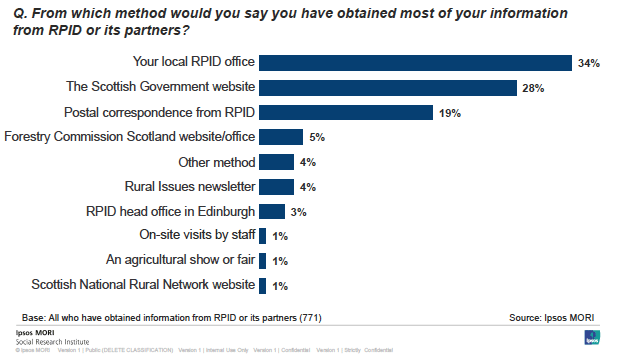
2.16 Respondents who had submitted a paper SAF application were more likely than overall to say that their local RPID office was their main source of information (43% versus 34%) while online SAF applicants (38%), male respondents (30%) and those in the 25-40 age group (39%) were more likely than overall to say their main source of information was the Scottish Government website.
2.17 Online respondents' main source of information was the Scottish Government website (36%, compared with 25% of telephone respondents), while telephone respondents were more likely than online respondents to report postal correspondence from RPID as their main source of information (25% compared with 8%).
2.18 Those dissatisfied with RPID (21%), other rural businesses (19%), agents (18%) and those in the Southern region (14%) were more likely than overall (5%) to report the Forestry Commission Scotland website or office as their main source of information. Respondents in the Northern & Northern Isles region were more likely than overall to report this of the Scottish Natural Heritage website or office (3% compared with 1%).
2.19 Of respondents whose main source of information was their local RPID office, almost half (46%) mainly contacted the office by telephone, with 30% visiting the office in person. Smaller proportions mainly obtained information from postal correspondence (16%) or by email (7%), as shown in figure 2.5 below.
Figure 2.5: Main method used to obtain information from RPID local offices
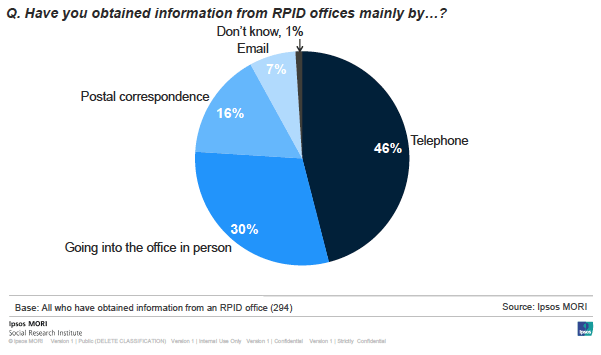
2.20 Farmers (46%), respondents in the 41-64 age group (56%) and online SAF applicants (56%) were more likely than overall to contact RPID by telephone; while crofters (49%), respondents in the Northern and Northern Isles region (48%), those in the over 65 age group (44%), and paper SAF applicants (40%) were more likely than overall to visit their local office in person.
2.21 Respondents to the telephone survey were more likely than online respondents and overall to report going to the local office in person (37% compared with 25% and 30% respectively). Conversely, telephone respondents were less likely than overall to obtain information from their local office by email (3% compared with 7%).
2.22 Respondents were asked which methods they would prefer to use to obtain information from RPID and its partners in the future. Similar proportions of respondents said that they would like to obtain information from their local office (56%), through postal correspondence from RPID (56%), by emails or texts from RPID (55%), while around half said they would like to receive information from the Scottish Government website, with 38% mentioning the Rural Issues newsletter. Overall results are shown in figure 2.6 below.
Figure 2.6: Preferred methods for obtaining information from RPID or partners
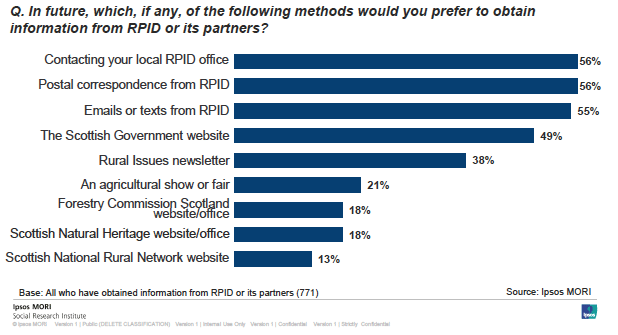
2.23 The offices or websites of both Forestry Commission Scotland and Scottish Natural Heritage were mentioned by a similar proportion of respondents (18% in each case).
2.24 Receiving information by email or texts from RPID or from the Scottish Government website was more likely than overall to be a preference amongst agents (68% and 63% respectively for email and text), online SAF applicants (65% and 59%), and those aged 25-40 (77% and 62%) and 41-64 (58% and 53%). Young farmers (those aged under 40) were more likely than overall to express a preference for information by text or email (73% versus 55% overall).
2.25 Agents (67%) and respondents who are satisfied with RPID (64%) were more likely than overall to express a preference for receiving information from their local office. Farmers (62%), paper SAF applicants (70%), and those in the South Western (71%) and Southern (69%) regions were more likely than overall to wish to receive information by post.
2.26 Telephone respondents were more likely than online respondents to wish to receive information by post (73% compared with 40%), or from their local office (66% compared with 47%); while online respondents were more likely than telephone respondents to prefer to obtain information by emails or texts from RPID (59% compared with 51%).
2.27 Agents (50%), other rural businesses (38%), non-SAF applicants (43%), and respondents in the Southern region (29%) were more likely than overall to wish to receive information from the Forestry Commission Scotland website or office. Similarly, agents (38%), other rural businesses (34%), non-SAF applicants (43%) and those in the Southern region (31%) were more likely than overall to say that they wished to receive information from the Scottish Natural Heritage website or office.
2.28 Telephone respondents were more likely than online respondents to prefer to obtain information from the SHN website or office (24% compared with 12%) or the FCS website or office (23% compared with 14%).
Figure 2.7: Current and preferred methods for obtaining information from RPID or partners
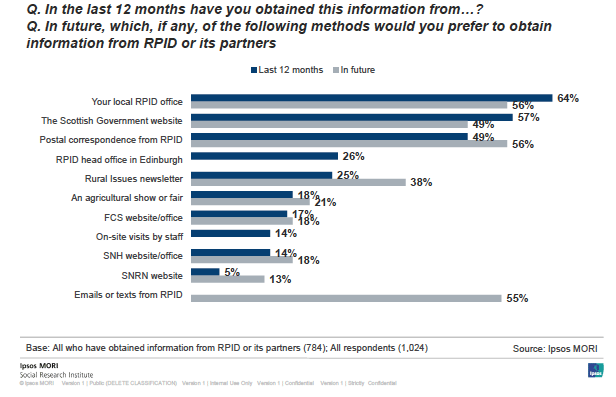
2.29 As figure 2.7 above shows, there is some difference between the ways in which customers currently receive information from RPID and its partners and the ways in which they would like to do so in future. Respondents seem to express more of a preference for information being sent to them by post, text or email, or in the Rural Issues newsletter, while they are less likely to wish to use their local office or the Scottish Government website.
Key points
2.30 The types of information most commonly requested by respondents related to guidance on completing an application, or relating to their own specific application or payment. It may be that such requests are highly specific to the needs of each individual customer and, as such are a driver of the type of contact which customers will use: if a customer does not understand questions on a form this will steer them towards contacting a local office in person or by telephone, since a set of Frequently Asked Questions on the Scottish Government website may not necessarily help the customer with the specific difficulty they are experiencing. Similarly, those who seek information on eligibility or the conditions that apply to schemes may feel that they need to speak to a member of staff in order to seek proper clarification or assurances from another person. Conversely, those who are looking for news about rural or agricultural issues may be more prepared to go to a website because they can do this at their convenience.
2.31 For future communication, more than half of respondents (59% of online and 51% of telephone respondents) mentioned that they would be happy to receive text or email communications from RPID. This would suggest that as part of the Scottish Government's digital agenda, RPID could reduce postal correspondence with its customers and move to electronic communication. This would reduce printing costs for standard letters, and electronic versions of leaflets and brochures would also be easier to produce and be beneficial for the environment. The majority of contact seems to still be by telephone, with information posted to customers, but this could gradually be changed to a default of responding by email with links to online sources.
Contact
Email: Angela Morgan
There is a problem
Thanks for your feedback